E3 2011: Editor impressions of the Sony press conference
GR Editor Mikel Reparez and PlayStation: The Official Magazine Editor-in-Chief Gary Steinman share their thoughts
Sony%26rsquo;s really committed to 3D

Seemingly every gameplay presentation at the press conference was in 3D, and just about every first-party game showcased was revealed to support it. In case there was any doubt, though, Sony underlined the importance of widespread 3D adoption with a $500 monitor bundle aimed at those who can’t afford a TV that costs more than $1,000. Also of interest: Cheaper 3D glasses, and a two-player mode that uses the 3D tech to do away with split-screen, replacing it with two separate images that each player’s glasses are synchronized to see. Whatever you think of 3D as a standard, that’s a pretty cool idea.
Now, if only the TV was a little bigger...
It%26rsquo;s also really committed to Move... sort of
What a difference a year makes. A year ago, we were hearing not just about how Move would open gaming to a new, more casual audience, but also that it would enable exciting new types of play. This year, we learned two different things about the motion-control peripheral, the first being that Sony is totally committed to it. Nearly every first-party game will support Move, and it was frequently mentioned and demonstrated throughout the conference.

The second is that it’s being sold to developers with the idea that it’ll make their games more accessible to people who are terrified of buttons and thumbsticks.Ken Levine’s somewhat sheepish presentation on how Move would make Bioshock Infinite more accessible was evidence of this, as was Kobe Bryant being trotted out to demo NBA 2K12 with Move. The message was apparently that if an NBA star can play an NBA game with Move, then anyone can (which is kind of a bizarre message if you think about it for more than five seconds).
Sign up to the GamesRadar+ Newsletter
Weekly digests, tales from the communities you love, and more
True, I’m more comfortable with the idea of playing, say, a shooter with Move than I am with the bizarre puppeteering Kinect controls demonstrated for Ghost Recon: Future Soldier at the Microsoft press conference. At least developers understand how to use it to enable clear gameplay concepts. But is Move really the preferred method of entry for grandmas and the controller-phobic? Really?

Meanwhile, the only game that on display that seemed to do anything potentially interesting with the technology was Medieval Moves: Deadmund’s Quest, which came out of left field in place of the strangely absent Sorcery. However, given its cartoony appearance, its serious-game cred is still in question until we get more time with it.
Cole MacGrath seems like a good fit for Street Fighter X Tekken

If nothing else, I’m a little surprised at this one. After seeing Kratos shoehorned into two third-party fighting games now, I kind of figured he’d be the default, PlayStation-exclusive cameo character. But seeing InFamous’ Cole MacGrath rendered to look like a Street Fighter IV character was strangely appropriate, and his lightning powers – which included a few from InFamous 2, like the Lightning Tether – seem perfectly suited for a game where shooting fireballs from your hands is considered a basic, run-of-the-mill move. It’ll be interesting to see how he handles when we finally get our hands on the PSV version.
The Last Guardian was a disappointing no-show

Not only was The Last Guardian strangely absent from Sony’s presentations – it was nowhere to be seen. While the remastered versions of Ico and Shadow of the Colossus were playable on the post-conference show floor, Last Guardian didn’t get so much as a hands-off demo reel. Is it possible the game’s even further away than we’ve been led to believe? Whatever the case, it was a massive downer to see it so completely shut out of the festivities.
Impressions from PlayStation: The Official Magazine
Editor-in-Chief of PTOM Gary Steinman had this to say: "Sony nailed it again for the second year in a row by focusing on core game experiences. Even better, they got the Vita price right." A man of few words, but to the point.
Jun 7, 2011
Most Popular





